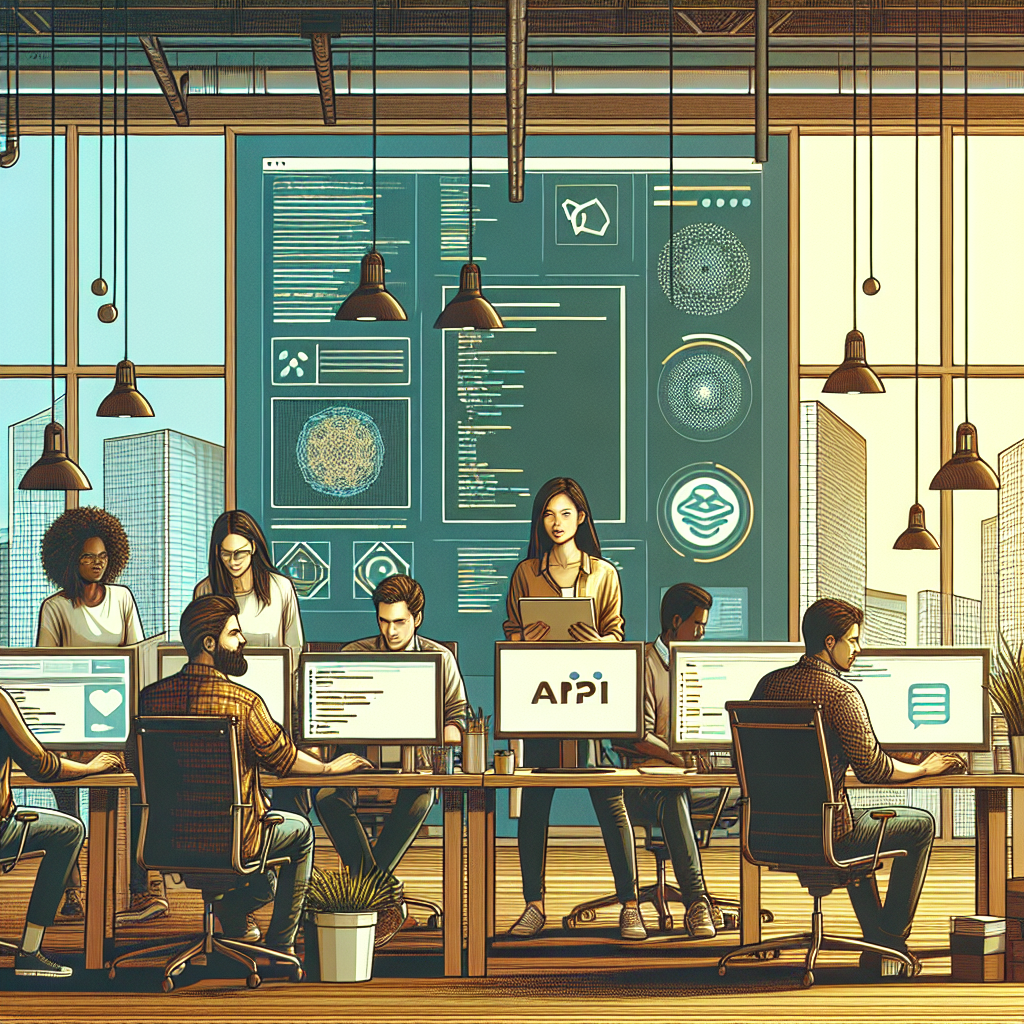In the rapidly evolving world of software development, API-First Development has emerged as a pivotal approach for modern businesses aiming to streamline their application interfaces. Unlike traditional development methods that consider APIs as an afterthought, API-First Development places APIs at the forefront of the development process. This methodology ensures that APIs are designed and implemented as the primary components of the application, leading to more consistent and scalable solutions.
Adopting an API-First strategy means that developers create a contract-first approach, outlining the API’s specifications before any code is written. This approach fosters better collaboration between cross-functional teams, including front-end and back-end developers, ensuring that everyone is aligned with the API’s design and functionality from the outset. As a result, the development process becomes more efficient, reducing the likelihood of miscommunications and costly rewrites.
The benefits of API-First Development are manifold. By prioritizing the API design, businesses can achieve greater flexibility, allowing for easier integration with third-party services and other applications. Moreover, this approach enhances the user experience by providing a more seamless and reliable interface for end-users. Additionally, by leveraging tools like OpenAPI and Swagger, businesses can automate documentation and testing, further streamlining the development lifecycle.
Ready to transform your business with API-First Development? Get a quote from Guru Internet Services today and let us help you achieve absolute web success!
Benefits of API-First Approach

Embracing the API-First Approach offers numerous advantages that can significantly enhance the efficiency and scalability of your application development process. One of the primary benefits is the improved consistency and standardization of APIs. By designing APIs as the foundation of your development efforts, you ensure that all components of your application adhere to a unified structure, promoting easier maintenance and future updates.
Another significant advantage is the enhanced collaboration between development teams. When APIs are the focal point, both front-end and back-end developers can work in parallel, using the API specifications as a blueprint. This parallel development reduces bottlenecks and speeds up the overall project timeline, allowing for faster deployment and iterations.
The API-First Approach also facilitates better integration with third-party services. Since APIs are designed to be reusable and modular, they can easily be incorporated into other applications or services, enabling seamless data exchange and functionality expansion. This modularity is crucial for businesses looking to scale their operations or integrate with partners and external platforms.
Moreover, an API-First strategy enhances user experience. By prioritizing the design and functionality of the API, developers can create more reliable and responsive applications. This focus on the API layer ensures that end-users enjoy a consistent and high-performing interface, leading to greater satisfaction and engagement.
Lastly, the use of API-First Development supports automation in testing and documentation. Tools like Swagger and OpenAPI allow for the automatic generation of API documentation, making it easier for developers to understand and utilize the APIs. Automated testing ensures that APIs function as intended, reducing the risk of errors and improving the overall quality of the application.
Best Practices for API-First Design

Implementing best practices for API-First Design is essential to fully leverage the advantages of this approach. One of the foundational practices is to define clear API specifications from the outset. Using tools like Swagger or OpenAPI, you can create detailed documentation that outlines the endpoints, methods, data models, and expected responses. This clarity ensures that all development teams are on the same page and can adhere to the predefined standards.
Another crucial best practice is to focus on simplicity and consistency. APIs should be designed with a user-centric approach, ensuring that they are intuitive and easy to use. Consistent naming conventions, error handling, and authentication methods can significantly improve the developer experience and reduce the learning curve for new users.
It’s also important to emphasize scalability and flexibility in your API design. As your application grows, your APIs should be able to handle increased load and adapt to new requirements. This involves designing APIs that are versioned and backward-compatible, allowing for incremental updates without disrupting existing integrations.
Security should never be an afterthought in API-First Design. Implementing robust authentication and authorization mechanisms, such as OAuth2, ensures that only authorized users can access your APIs. Additionally, encrypting data in transit and at rest protects sensitive information from potential breaches.
Lastly, it’s essential to incorporate thorough testing and monitoring into your API development lifecycle. Automated testing frameworks can help validate the functionality and performance of your APIs, while monitoring tools provide real-time insights into their usage and potential issues. This proactive approach enables you to maintain high-quality APIs and quickly address any problems that arise.
Tools and Technologies for API-First Development
To excel in API-First Development, leveraging the right tools and technologies is crucial. One of the most popular tools is Swagger, now known as the OpenAPI Specification (OAS). Swagger provides a comprehensive framework for designing, building, and documenting APIs. It allows developers to define API endpoints, request/response formats, and automatically generate interactive documentation that facilitates easier integration.
Another powerful tool is Postman, widely used for testing and monitoring APIs. Postman simplifies the process of making HTTP requests, validating responses, and automating tests. It also supports collaboration features, enabling teams to share API collections and ensure consistency across development environments.
For managing API gateways and microservices, Kong and Apigee stand out as leading solutions. Kong is an open-source API gateway that offers features like load balancing, rate limiting, and authentication, while Apigee provides a comprehensive platform for API management, including analytics, security, and developer portals.
When it comes to API versioning and backward compatibility, tools like SemVer (Semantic Versioning) are essential. SemVer provides a standardized way to version APIs, making it clear when changes are backward-compatible or introduce breaking changes.
For continuous integration and deployment (CI/CD) of APIs, platforms like Jenkins and GitLab CI are invaluable. These tools automate the building, testing, and deployment of APIs, ensuring that new changes are seamlessly integrated and deployed to production environments.
Finally, incorporating API monitoring and analytics tools such as New Relic and Datadog can provide real-time insights into API performance and usage patterns. These tools help identify bottlenecks, track response times, and ensure that your APIs are meeting SLAs and user expectations.
Case Studies of Successful API-First Implementations

Exploring real-world case studies of successful API-First Implementations provides valuable insights into the tangible benefits of this approach. One notable example is Stripe, a leading payment processing platform. Stripe’s API-first strategy has enabled it to offer flexible and scalable payment solutions that developers can easily integrate into their applications. By prioritizing API design, Stripe ensures that its services are consistently reliable and developer-friendly, resulting in widespread adoption and satisfaction.
Another exemplary case is Twilio, a cloud communications platform that provides APIs for messaging, voice, and video. Twilio’s API-first development model has allowed it to innovate rapidly and maintain a high level of service reliability. By offering comprehensive API documentation and robust SDKs, Twilio empowers developers to build complex communication solutions with ease, leading to its rapid growth and market dominance.
Similarly, Netflix has leveraged API-first development to enhance its streaming service. By creating a highly modular and scalable API architecture, Netflix can deliver a seamless user experience across a multitude of devices and platforms. This approach has also facilitated continuous innovation, allowing Netflix to quickly roll out new features and adapt to changing user demands.
Another success story is Salesforce, a leading customer relationship management (CRM) platform. Salesforce’s API-first approach has enabled it to build a robust ecosystem of third-party applications and integrations. By providing comprehensive APIs, Salesforce ensures that its platform can be easily extended and customized to meet the unique needs of its diverse customer base.
Lastly, Shopify, an e-commerce platform, exemplifies the power of API-first development. By offering a suite of APIs for developers, Shopify has created a vibrant marketplace of apps and extensions that enhance its core functionality. This extensibility has been a key factor in Shopify’s success, allowing it to cater to a wide range of businesses and industries.
Future Trends in API-First Development

The landscape of API-First Development is ever-evolving, and several emerging trends are poised to shape its future. One significant trend is the increased adoption of GraphQL. Unlike traditional REST APIs, GraphQL allows clients to request exactly the data they need, reducing over-fetching and under-fetching of information. This flexibility is particularly beneficial for complex applications with diverse data requirements.
Another promising trend is the integration of AI and machine learning into API ecosystems. APIs that leverage AI can offer advanced capabilities such as predictive analytics, natural language processing, and personalized user experiences. As AI technology continues to advance, we can expect to see more intelligent and adaptive API solutions.
Microservices architecture is also gaining traction in the API-first development space. By breaking down applications into smaller, independent services, developers can achieve greater scalability, flexibility, and resilience. This approach facilitates continuous deployment and allows teams to iterate quickly, delivering new features and improvements more efficiently.
Moreover, the emphasis on API security is becoming increasingly critical. As APIs become more pervasive, they also become prime targets for cyberattacks. Future trends will likely focus on enhancing API security measures, including robust authentication, authorization, and encryption protocols to protect sensitive data.
Additionally, the rise of serverless computing is transforming how APIs are deployed and managed. Serverless architectures allow developers to build and run applications without managing the underlying infrastructure, leading to lower operational costs and improved scalability. This trend is expected to drive the adoption of API-first development even further.
Lastly, the growing importance of developer experience (DX) cannot be overlooked. Companies are increasingly recognizing the value of providing comprehensive documentation, intuitive API design, and responsive support to foster a positive developer experience. This focus on DX will continue to drive innovation and adoption of API-first strategies.
Stay ahead of these trends and ensure your business thrives in the digital age by exploring how API-first development can transform your applications. Get a quote at https://guru-is.com/#contact


